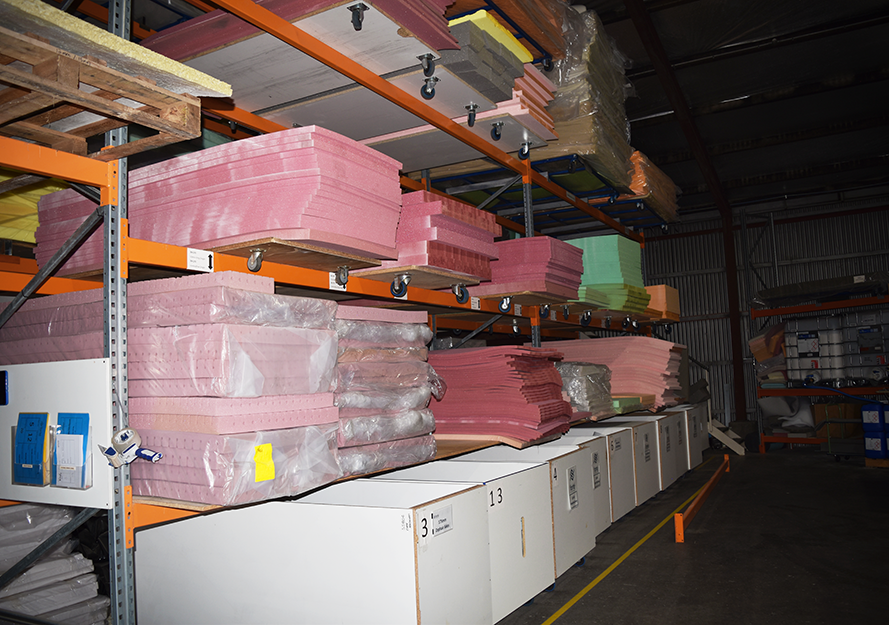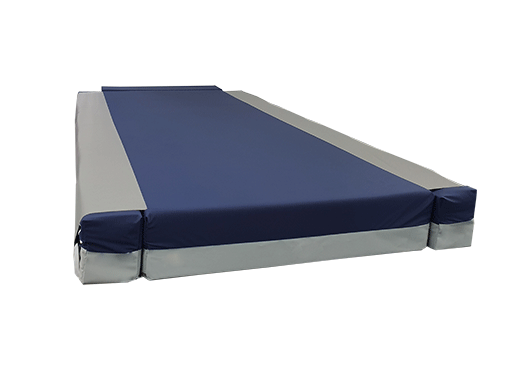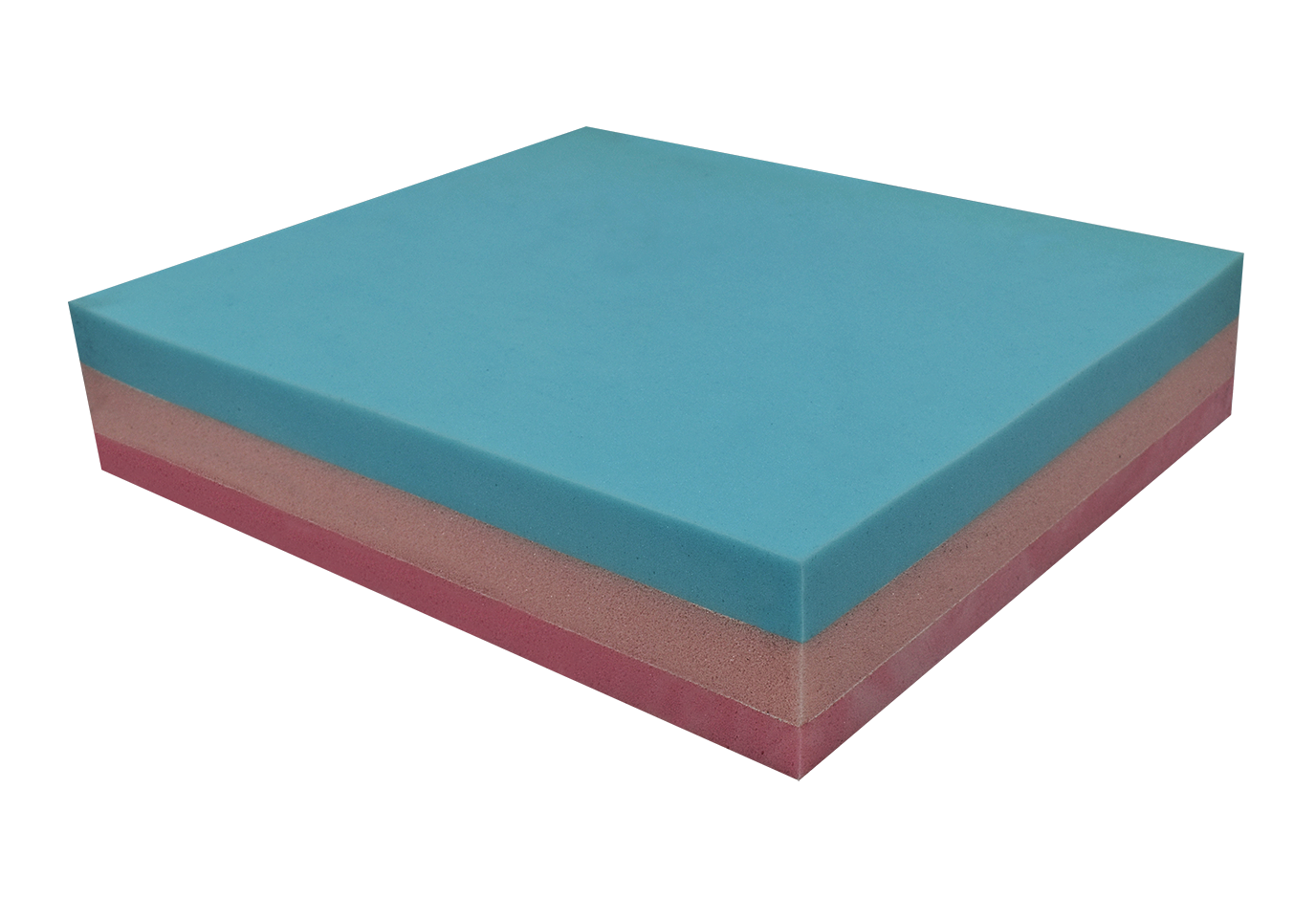Icon Maxx 500kg Bariatric
Icon Maxx 500kg Bariatric Care Pressure Care Mattress
The Icon Maxx 500kg mattress is a 4-layered static foam bariatric mattress with firm hinged strengthened sides, segmented base and Advantiflex Classic pressure care cover. The Icon Maxx 500kg is a high performance mattress suited to clients between 120-500kg with a medium risk of pressure injuries. This therapeutic weight loading is achieved through a 20cm premium specification and grading of pressure redistributing, comfort, supportive and foundational foam grades. The base two foam layers are split into three segments to allow the firm mattress to contour effective on a profiling bed. The Advantiflex Classic cover on the Icon Maxx is supplied with an extra heavy PVC base to provide additional durability. The Icon Maxx 500kg is the fitting choice for bariatric clients looking to achieve comfort, longevity and effective patient care.
Features

AIROFORM MEMORY IMMERSION INTERFACE LAYER – MEDIUM
- High Temperature Stability to deliver consistent immersion, performance and comfort
- Maximises Patient contact with Support Surfaces Providing Pressure
- Redistribution
- Alleviates localised pressure points
- Depth calibrated to maximise functionality and patient mobility
- Visco-elastic/Memory Foam cell structure provides low-shear surface
- Firmness: Medium

PREMIUM POSTURAL SUPPORT SECONDARY LAYER
- Graded support and patient comfort in supine, prone, lateral and
- fowler positions
- Excellent core stability to encourage centralised patient positioning
- Provides protection against ‘bottoming-out’ during transfer,
- repositioning and whilst in the inclined/fowler position
- Graded for ultimate patient support to minimise falls risk, entrapment and enhance pressure redistribution

PREMIUM FIRM FOUNDATION LAYER
- Provides protection against ‘bottoming-out’ during transfer, repositioning and whilst in the inclined/fowler position
- Provides exceptional comfort, support for repositioning and patient care

TRIPLE SECTION, SPLIT FOUNDATION LAYER
- Enhances profiling with adjustable bed surface positions minimising excess strain on bed mechanisms

HINGED STRENGTHENED SIDES
- Increase lateral stability of support surface
- Improves patient safety and encourages central patient positioning
- Make patient transfers easier
- Unique hinge profile reduces foam fatigue and allow mattress to easily
- conform to varied bed positions
- Enables ease of primary patient care

ADVANTIFLEX CLASSIC PRESSURE CARE COVER
- Advantiflex PU1100 Pressure Care Polyurethane Upper Material: 4-Way Stretch, Vapour Permeable, Blue
- Extra Heavy Duty PVC Base Material: Durable, 100% Waterproof, Grey
- Infection Control & Compliance: Inherent Anti-Microbial Protection, Fire retardant, High frequency sealed and welded seams
- Construction: Two-sided / 180° high frequency welded zipper, Zipper waterfall protection flap, High frequency sealed and welded seams
About the Icon Maxx 500kg
Bariatric Care Pressure Care Mattress

Heavy Duty

Firm Strengthened Transfer Sides

Anatomical Support

Firm Foundation Layer
THERAPEUTIC OR SAFE WEIGHT RANGE
Therapeutic Weight Range (TWR) refers to the weight range which the mattress performs to a clinically effective level. TWR is especially important for static foam mattresses as they have a defined limit whereby the foam properties fail and over compress. At this point, the support surface is not providing therapeutic function and should not be used.
The Safe Weight Range (often referred to as Safe Working Load) is defined as the maximum and minimum permissible load that can be safely supported by the mattress. SWR is usually broader than the TWR.
To get the most out of your mattress from both a clinical and longevity aspect, it is best to follow the therapeutic weight range.
When prescribing or selecting a mattress it is very important to consider the weight of the individual currently and expected weight in the future. For example, if your 328kg client who is continuing to gain weight requires an Icon Maxx 350kg (TWR 90-350kg), it would be recommended to go with the Icon Maxx 500kg (TWR 150-500kg).
BARIATRIC CARE – PRESSURE INJURY PREVENTION
Bariatric and/or Obese patients have an increased risk of pressure injuries and maintaining skin integrity is one of the challenges that nurses, and caregivers will encounter. The main reason is because of bariatric patients’ immobility, but also due to changes in skin physiology due to a greater skin–weight ratio, reduced vascularity, increased sweating, and perfusion in adipose tissue. All these side effects can all result in increased risk of PI development, and poor wound healing.
It is important to apply preventive measures for bariatric patients and to provide advanced wound care if pressure injuries occur. Appropriate equipment provision is key to maintaining skin integrity, patient dignity and well-being. In some cases, it is the provision of inappropriate equipment can be a contributory factor to pressure damage. For example, if a support surface is used for an individual over the advertised therapeutic weight limit the mattress will bottom out and will not provide support or immersion at the area of most pressure (usually sacral region). Increased localised pressure in this region will cause a pressure injury if not addressed promptly.
Bariatric patients may have difficulty repositioning themselves and nurses may be reluctant to turn and reposition the patient due to their realistic fear of injury and lack of training in how to safely manage heavier patients. Without the movement incurred in repositioning, the patient can sustain friction and shear damage and atypical pressure injuries in the skin folds. Support surfaces used for Bariatric patients must enhance the ability of the individual to reposition, for example, features such as firm strengthened sides.
Weight shifting is essential to avoid pressure damage whether the patient is in bed. Choosing and implementing the right bariatric equipment can help to facilitate independence. Much of the equipment needed is specialised, is made from heavy duty materials, and will require training in its use.
Beds should support the weight of the patient and be wide enough to enable movement and repositioning within the bed.
Dynamic or alternating air mattresses can make individuals dependent, as getting in and out of, and moving around in bed is more difficult than with a foam mattress. The risk of increased dependence should be considered when allocating a mattress, especially within the community environment. Forté recommend the best solution for bariatric individuals with very high risk of obtaining a pressure injury should use a static bariatric mattress with static air ROHO sections located in the at-risk areas.

FIRM SIDE WALLS
The Icon Maxx has inbuilt firm side walls constructed of an ultra-high density foam, engineered with a profile hinge system to reduce falls risk and provide enhanced stability, especially for bariatric clients. Side walls significantly help reduce the effort required to transition on or off sleep surface and assist with repositioning and other tasks. Therefore side walls are important for any users with limited strength.
Inbuilt strengthened sides reduce the risk of foam compression on the mattress edge, and subsequent user ‘roll-out’. Firm, rigid edging provides structural support for transfer, ingress, and egress. Forté side walls make primary care easier and suit the use of transfer and mobility aids such as slide boards. This is particularly important for bariatric patients as primary care is typically a more difficult task for staff.
Forté side walls have been designed with a unique integrated hinge system to reduce tension & compression in foam when used with a profiling bed. Reducing tension aids overall mattress longevity. The hinge system allows the mattress to easily articulate for the maximum benefit of electronic bed function.

REACTIVE SUPPORT SURFACES; PRESSURE REDISTRIBUTING STATIC FOAM
A Reactive support surface is a powered or non-powered support surface with the capability to change its load distribution properties only in response to an applied load. Reactive support surfaces may be powered (active) or nonpowered (static). In comparison to an alternating pressure relieving mattress, reactive surfaces provide a constant low-pressure profile whereby the pressure at every contact point is reduced. The patient can be immersed and enveloped by the surface which increases the area of contact with the patient’s body and the reactive support surface.
Reactive support surfaces come in many different types including:
- Foam – mattress composed of foam or layers of foam with different densities and shapes. For example, Forté Icon Medium Care Mattresses.
- Air or Gel Filled – surfaces comprise air or gel-filled compartments. For example, ROHO Integrated Systems.
- Hybrid – surface combining foam and air technology to maximise the benefits offered by both static and alternating surfaces.
- Low air loss – some air-filled support surfaces allow air to escape through small holes. The air flows along the inside of a vapour permeable patient contact layer. This draws moisture and heat through the contact layer and away from the skin. Low air loss aids control of moisture on a patient’s skin.
- Air-fluidised – contain sand-like particles through which air is forced. As the air is forced through the particles, they take on the properties of a liquid. The porous cover allows air to escape out of the mattress and body fluids to flow down into the support surface
“Pressure redistribution is achieved by either increasing the body surface area that comes in contact with the support surface through immersion and envelopment (to reduce concentrations of weight over bony prominences) or sequentially altering the parts of the body that bear the load, thus reducing the duration of loading at any given anatomical site”. Prevention and Treatment of Pressure Injuries: Clinical Practice Guideline. The International Guideline 2019.



You’re Covered by Forté Healthcare’s ‘Successful Solution Guarantee’
At Forté Healthcare, we are so confident in the care and performance our support surfaces deliver, that we back our products and expertise with our ‘Successful Solution Guarantee’.
Here’s how it works:
Our team of specialists will help you navigate our product range to correctly match our support surfaces with your care environment and patient risk profile. This ensures you achieve the highest levels of patient care and pressure injury prevention.
If, for whatever reason the product we recommend isn’t helping you achieve the outcome you expected, we’ll work with you until it is. And in the unlikely event we still cannot provide the right solution.
We’ll refund you 100% of the charges to date.







